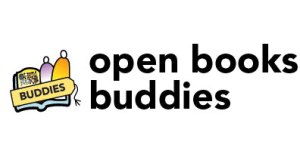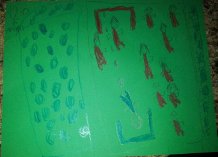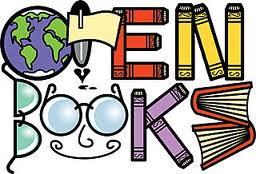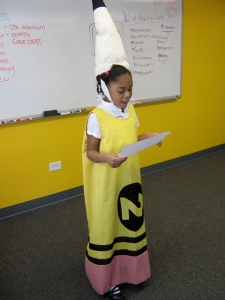As the world celebrated Martin Luther King, Jr Day on Monday, I remembered the field trip that I coached just a week ago. Fifth-graders were asked to write a poem about the dreams for their future. And how noble and ambitious they were! One student wanted to stop animal abuse and all anger in the world, another one said she would be happy if only all bullying stopped. A shy girl who had been quiet all morning, volunteered to read her poem at the end of the class. She wrote that she wanted to fight for civil rights when she grows up. Because this country isn’t free yet…Such a deep thought for a 10y.o.! Sadly, she is right. There is still inequality, racism, people are being shot every day even though there isn’t any war. That girl later confessed that Dr.Martin Luther King, Jr. inspired her because he fought PEACEFULLY and used words as his weapon in order to change the world he lived in…
Kids like these are, without a doubt, our brighter future!
Here is the girl’s poem:
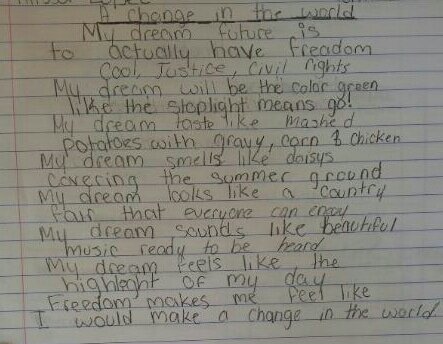

ReadThenWrite at Mitchell: Two Sides of Every Story.

What can be better than reading an engaging and mind-opening book with children? Right, helping them to write their own pieces based on the book they’ve read. This is exactly what I did along with other writing coaches and leader Anna at Mitchell Elementary School this fall. Twenty students from various backgrounds who attend 6-8th grades took part in ReadThenWrite program and became published authors at the end.
 The book that we read holds a special place in my heart. “Wonder” by R.J.Palacio is a story about a boy who was meant to stand out. Auggie, a sweet and tough 10-year old, who was born with distorted facial features, has been homeschooled by his mother. When his parents decide to enroll Auggie in a regular school, a beautiful story of challenges and acceptance begins. R.J. Palacio said that the book was inspired by a real-life encounter of her own kids six years ago with a girl with a serious facial deformity. You can read a great interview with the author here. The book is written from the points of view of Auggie, his sister, sister’s boyfriend, sister’s best friend, and Auggie’s new friend Jack Will. This helps to remind us that there is always more than one side to a story…
The book that we read holds a special place in my heart. “Wonder” by R.J.Palacio is a story about a boy who was meant to stand out. Auggie, a sweet and tough 10-year old, who was born with distorted facial features, has been homeschooled by his mother. When his parents decide to enroll Auggie in a regular school, a beautiful story of challenges and acceptance begins. R.J. Palacio said that the book was inspired by a real-life encounter of her own kids six years ago with a girl with a serious facial deformity. You can read a great interview with the author here. The book is written from the points of view of Auggie, his sister, sister’s boyfriend, sister’s best friend, and Auggie’s new friend Jack Will. This helps to remind us that there is always more than one side to a story…
During this program we focused on developing reading strategies and building engagement with the literature. We taught our students that there are six Active Reading Strategies(ARS) they should use in order to become successful readers:
Strategy 1: VISUALIZE. Readers create a picture or image of what is being described in the story. This strategy is good to use when people or places are introduced and/or described in a story.
Strategy 2: CLARIFY. In their own words, readers restate what they just read in the text. This helps readers better understand the main idea of stories, as well as simplify dense text.
Strategy 3: CONNECT. Readers identify connections between their lives and the events of the story. They can also find similarities between the current stories they are reading and previous stories they have read. These connections are referred to as text to self (TS) or text to text (TT), respectively.
Strategy 4: PREDICT. Readers make predictions, or educated guesses, about what will happen next in the story. This encourages readers to synthesize the events that have been occurring in the story.
Strategy 5: QUESTION. Readers ask questions about what is happening in the story. This strategy is useful when new characters or information are referenced.
Strategy 6:EVALUATE. Readers form their own opinions and /or conclusions about characters and events in a story.
The students filled out many knowledge quizzes along the way and earned points for completing their homework. At the end of the program they could redeem the points for free books, candy, or stationery.
For our writing assignment students wrote two narratives. The first one had to be written from their point of view and tell the audience about a conflict they had with another person at one point. The second narrative had to be written from the perspective of the other person in the conflict that they had, and tell that person’s side of the story.
The students used Venn Diagram where “A” was a private(1st person) POV, and “B” – public(3rd person) account of the event, to find out what they share and how it would affect their narratives.
We also explained the importance of inference, when the author uses details to show the character’s personality and traits vs. just telling the readers about it. We used “Mystery bag” activity to illustrate it. Site leader Anna brought a bag with different objects in it to the class. She let the student who picked one object from the bag infer about a person who owns the object. For example, a notebook with lots of neat notes might make one think it belongs to an organized person.
With the help of their coaches and peers the students completed outlines for their stories. And then my favorite part started: writing, editing, dealing with writer’s block, more writing, spicing up the language, final editing…and completing author’s bios.
“Two Sides of Every Story”, an anthology of their stories, was published by Open Books. In December the students of Mitchell Elementary came to the Open Books Bookstore for their Author Launch.
I should say it was an honor to work with Mitchell Elementary students! It was great that every coach was assigned a small group of students and could make sure that everyone got an undivided attention. Together with Diane and Kassandra, my ReadThenWrite students, we formed what we called “Only Girls Club”. We became not only a strong academic group, but also friends. And that is what matters the most to me.

Our “Girls Club” group: me, Diane(left) and Kassandra(right). What a pleasure it was to work with these girls!
In winter 2014 Open Books will launch ReadThenWrite program in different schools in the City of Chicago. If this post has inspired you to try yourself as a writing coach in this program, please feel free to follow this link and browse for more information. Or you can email Ava Zeligson, Volunteer Manager, at azeligson@open-books.org and ask her to contact you in regards to the program.
Thank you and Good luck!

Chicago Writers Conference’13
“There is no such day when I find myself without stories or
ideas swarming around me.”
Rick Kogan, an icon of Chicago journalism and a keynote speaker at CWC’13.
I was blessed to attend Chicago Writers Conference last month with my friend, talented writer Madelaine Standing, who came all the way from Canada.
CWC’13 started with a Kick-Off party at Open Books Bookstore where I volunteer. Besides socializing and making new friends, conference attendees were entertained by special readings of Chicago Stories by performers from This Much Is True.
For the next two days the conference took place in Harold Washington Library Center of the Chicago Public Library.
One of the most interesting presentations for me on the first day was that of Ian Belknap, the founder of “Write Club” – a lineup of Chicago writers/performers who compete in performing for cash going to a charity of their choosing. Ian gave advice on performing writer’s work in front of the audience and capturing listeners’ attention. Here are a few tips from Ian on how to be an excellent reader:
1. Always keep in mind that the goal of reading is to deliver the message, tantalize the audience.
2. It’s always better to choose simplicity when reading an excerpt from your book. If a sentence can’t be read in one breath, it has to be rewritten. Dialogue would probably be a bad choice, unless it’s a breaking point in a story. But if you do read a dialogue, don’t change the way you talk with a change of the character. Instead, you can change a deepness of your voice or the way you turn your head.
3. When asked to read a 5-minute long piece, make it 4 minutes, and leave room for questions.
4. Not everyone is brilliant when it comes to public speaking. You may need to take a Live Lit class or public speaking class in your local university before performing your work.
5. Practice is the mother of excellence. Read aloud as if you are performing as much as you can; study your tendencies and improve them.
Shannon Downey from “Pivotal Chicago” shed some new light for me on social media as a tool for selling books. She stressed that once a writer defines social media as a marketing tool, she is screwed. Social media should be seen as a collection of tools that can help a writer curate a boundless community of people in a different way. Trust and authenticity are factors that will drive any social media. Instead of promoting your book on your website, become sort of “go-to” in your field. Less than 10% of your content should be about what you are selling.
Since I am interested in travel journalism and plan to attend Columbia College to get my MA in Journalism next year, I really enjoyed a presentation by Glenn Jeffers, an Editor of Kellogg Magazine, “How to Take “Free” Out Of Freelance”. He gave a step-by-step guidance for beginning freelancers to get their foot in the field:
- Get business cards. You never know whom you can run into.
- Create your website with your resume and short clips that show your ability to tell what happened in a precise manner.
- Do your research on editors of magazines/newspapers that you’re interested in and see what they’re currently looking for. Mediabistro.com is a great tool for this. It is a website that features news in publishing industry as well as writing jobs.
- Define what your area of expertise is and work hard to expand your knowledge.
- Improve your video/audio production knowledge.
- Try to submit your work to small publications: custom publishing companies where they have a small editorial staff and hire journalists-freelancers (i.e. Hemisphere Magazine by United Airlines or universities alumni magazines); regional publications such as Chicago Sun – Times or Red Eye. If your first work is spotless, you’ll become a sort of go-to for the editors.
- Join professional journalist groups such as Chicago Headline Club.
I feel overwhelmed with the gratitude for experiencing Chicago Writers Conference! Besides learning more about writing craft, I feel a part of Chicago creative community now.
Publishing Academy at Open Books: My Magical Summer
12 teenagers…
4 weeks…
Hours of writing…
3 volunteer writing coaches and editors…
4 Open Books Leaders…
…on the quest to publishing.
This is a summary (rather brief one) of what happened at the Publishing Academy program Open Books had this July. Twelve teenagers from Chicago Greater Area embarked on a journey of writing their own fantasy novels and publishing them with Open Books. And I had a pleasure of being one of their writing coaches!
First thing that struck me was that everyone had different fantasy stories, from the far-away kingdom tales to dystopian future epics, or a dreamland of a dying girl sick with cancer.
Open Books created a magical atmosphere that sparked imagination and had plenty of resources for writing.
During the first week, the students created and built engaging fantasy worlds. The coaches helped them by brainstorming ideas and making science fair poster boards with the description of the worlds.
The authors invented their main characters, protagonists and antagonists. The coaches explained what indirect and direct characterization was and assisted in developing characterization skits for all the characters.Open Books invited local artists to make sketches of the young authors’ main characters. This helped them visualize their main characters and connect to them better.
Next week, the students completed plot outlines and hero’s journey. We used The Hunger Games as an example of the character’s hero’s journey.
No good fantasy novel can do without combat scenes and action. During the second week Open Books invited martial art expert and creative writing teacher Jordan Bond to work on our students’ battle scenes. First, they discussed the difference between mentioning a fight and describing it in detail. Next, Jordan explained descriptive language to enhance battle scenes. What are synonyms for “defend” or “attack”? What kinds of weapons can be used and how they affect the person’s movement? What kinds of sounds can be heard during the fight? With this new knowledge, the students had a chance to write or refine a fight scene from their novel. Then they took turns reading their scene aloud as other students acted it out.
During the third week, guest speaker John Murphy, a game designer from Young Horses, discussed the overlap between writing and video game design with the students. He showed Young Horses’s new game, Octodad, and introduced TWINE – a software that is used to create interactive stories. The students had a chance to use it to develop their stories’ endings.
The students also learned how settings “show” the characters and how mood affects the type of story you are writing.
During the last week, the young authors wrote their author bios and had their photos taken for the book covers. They also had a chance to take part in front/back cover design.
Writing process included one-on-one conferences with the coaches, writing time alone, activities such as “question hat”, “put your character in a scene” etc.
Open Books Leaders created many incentives. Passports, for example, served to mark how many points the students had for completing their quests. Quests were tasks that we asked them to complete during each session (i.e. finish chapter or add character’s characteristics) or at home (i.e. write a review for the last fantasy novel they read). For each completed quest they got “coins” and stamps in their passport. They could later redeem their “coins” at the Open Books bookstore for used books.
At the end there were a lot of hugs, happy tears, and a pizza party. Finished line crossed!The author launch party took place in the Open Books Bookstore on September 19th 2013. The students, now published authors, read extracts from their books to the audience of their relatives and friends.
There was an autograph party afterwards and coaches-students reunion. And a sense of pride that we have accomplished such a big goal – a creation of the book from an idea to 70 or more well-written pages!
So, if any of you will ever take part in similar programs, I have a few tips:– Personal bond with teens is very important. Don’t talk down, but rather show your interest in them.
– Despite what you’ve heard, teens do need a “counselor”, an advisor figure. Don’t be shy to show your authority.
– When critiquing, first point out what you like about the work. Then move on to the areas that need improvement. I found it useful to write everything down on a separate paper for them.
– There is no such thing as “too much editing”.
Here are some tips for helping your students write:
- Encourage them to be good thinkers.
- Meet students where they are. Figure out where the students need help to get started, and begin there.
- Be excited, engaged, and curious, ask questions.
- Be a good listener. Some students struggle with getting ideas from their minds to the paper. Yet, they have no problem telling stories all the time. Before you even hand your students a pen and a paper, ask them to tell you their story, orally.
- Be an active part in the writing process. Regular check ins are a great way to make sure your students are on track.
- Celebrate the small victories and be specific about them.
- Set achievable goals.
The young authors talked about their experience and gave advice to the aspiring writers at the Authors’ Launch which you can check out here.
At the end, I think I got even more from this experience than my students. I exercised in brainstorming ideas, editing someone’s work…Publishing Academy helped me to be a better writer!
You can learn more and purchase books by Publishing Academy authors by following this link.
Open Books Reading Buddies
As a child, I liked to read with my grandmother. I remember her soft voice which opened a door to another reality for me, a fairy-tale land filled with characters I still love. One time when I was sick in bed with high temperature and couldn’t sleep all night, she read my favorite Peter Pen twice to me, and I think that was the main reason I felt better in the morning.
So when in July Open Books was looking for Book Buddies volunteers, I grabbed the opportunity to pay back all the time that my grandmother invested in teaching me to love the printed word. Book Buddies is a weekly literacy program the main purpose of which is to help boost students’ reading skills and add to their confidence about reading. Twice each week, volunteers read together with two Little Buddies in 30-minute segments. The program usually runs for a semester, but that time it was just for the month of July.
My Little Buddy was a first – grader Angel (it’s the cutest name ever, isn’t it?:). Now, it is crucial to build a relationship when working with kids of such a delicate age from day one. Open Books assisted in this by giving the students a survey to fill out about themselves at the beginning of the program. That’s how I learned Angel and I shared passion for soccer. Needless to say that the books that I chose for him to read were mainly about sport. Also, prior to the program, Open Books assessed the students’ reading levels. It made it really easy to choose the appropriate books. All the books brought to the site had labels on them with a difficulty level indication.
If any of you plan on reading with young children, these are the main points to consider in my opinion:
1. Build phonemic awareness and phonics (connection between letters and sounds). When you encounter an unfamiliar word, you can sound it out together or use a picture to give a clue to the word. Rhyming is also a great tool with young kids.
2. Make sure the children comprehend what they read. Ask them to retell the story in their own words. Prior to reading the book, build a background – ask them what they think the book will be about. Also, let them make predictions as you read.
3. Build their vocabulary. Challenge them to use new word in a sentence later in the day.
4. Work on their fluency. Read a book which was difficult for them couple of times.
And, of course, don’t forget to praise them for the progress they are making. Try to avoid the cliché “Good Job” though. Instead, try these phrases:
1. Praise for doing something right:
“I like the way you…”
“I had fun… today!”
“You should feel very proud of yourself for…”
“You learn so fast!”
“I really enjoyed working with you today because…”
“You are a great reader because…”
2. Encouraging a Struggling Reader:
“Great try at…”
“Don’t worry, you’ ll … next time!”
“Don’t give up on …! You’ ve almost mastered it!”
“You are getting better and better at… every day! You’ ve just got to keep trying!”
I can’t stress enough the support I had from Open Books site leaders and Program Directors! They were always around if volunteers had any questions and provided encouragement to Little Buddies. Open Books used Student Progress sheets that volunteers were required to fill out to track anything they could help with to make each session smoother.
Finally, nothing can compare to a child’s gratefulness and words like: “You are the coolest adult ever!” At the end of the program, the kids were asked to make the volunteers pictures or cards. This is what Angel made for me:
It’s us playing soccer. Unfortunately, I lose…J
In September I started Book Buddies program again at Mitchell Elementary School. This time it ran for a semester and involved third-graders. There are a few more things that I learned about reading with kids:
– If you are reading with two or more children, try acting scenes out(role-playing). It will make reading fun and prevent the kids from being bored waiting for their turn to read.
– Since the program ran for a few months, we could implement a system of encouragement for the Little Buddies. They got a sticker for every session they attended, and could redeem ten stickers for a free book of their choice. Sometimes I gave two stickers for one session if my Little Buddy went over the page goal we set up at the beginning of the session. That made my Little Buddies super excited!!!:)
Sweet Home, Chicago: Slam Poetry With Middle Graders.
Hey, everyone! Summer is gone and the season for vacations and time away from my laptop is over. I had a very busy summer though volunteering at Open Books and taking part in almost every literacy program they had:) In the next blog posts I will share this experience with you.
“Go Big or Go Home!”- these were the encouraging words that started each slam poetry performance at summer field trips on creative writing I was a part of. It means “express yourself to the fullest or leave”. Originated in Chicago as a competitive art of performance, slam poetry helped bring poetry into the masses and stop it from being still. All topics are safe and acceptable in slam; it explores what hurts the most and what is the most important for the author.
Slam is very popular in the Windy City. For instance, Young Chicago Authors(YCA) hosts Louder Than a Bomb Slam competition that gives young talent a chance to show themselves. At the field trips we used this video of Adam Gottlieb (a slam poetry star at YCA) to illustrate what an effective slam was:
https://www.youtube.com/watch?v=lXIjF0ERvYY&feature=youtube_gdata_player
A performance by Lamont Carey “I Can’t Read” is also a powerful example:
http://www.youtube.com/watch?v=_pgx4IX5Mi0
And so, at slam poetry field trips we taught our middle-graders to focus on WHAT they are saying with their work and most importantly HOW they are saying it, using body language, voice, and face expressions. The topics for their work the students could choose varied from the dreams for their future to their favorite activities. Since we asked them to describe something intangible, we told them to use five senses to talk about it. To warm up the students, we first created class slam poems about happiness:
Happiness looks like a rainbow.
Happiness tastes like buttery waffles with syrup.
Happiness sounds like pop music on a sunny Saturday while sipping lemonade at the beach.
Happiness smells like cotton candy flavored gum. Yum!
Happiness feels like winning the World Series.
…and summer:
To my surprise, when asked to write what they want to become, students’ answers ranged from a movie star or a cook to an astronaut. One girl touched my heart and the hearts of others when she wrote that the things she liked to do was not to feel medicine in her blood after she’d recovered from an illness…
Please, enjoy the poem about future dream my student and I created together:
My dream is to be a dancer.
Being a star. Practice makes perfect.
My dream is bright like the stage lights when people applaud me after the dance.
Being a star. Practice makes perfect.
My dream tastes like a big piece of watermelon that my mother cuts for me on a summer morning.
Being a star. Practice makes perfect.
My dream smells like a touch of a perfume before the dance performance.
Being a star. Practice makes perfect.
My dream looks like beautiful costumes made especially for me.
Being a star. Practice makes perfect.
My dream feels like sore muscles after a tough training.
I want to become a dancer. I want to feel elevated.
August’s Vol-Star is the Inimitable Olga Ivanidi!
http://openbooksorg.tumblr.com/post/57526081398/augusts-vol-star-is-the-inimitable-olga-ivanidi
Thank you,Open Books, for enriching my life and giving me the chance to serve others! I am very honored to be a volunteer of the month!
“Colorful Me” Field Trip
Brown
My face.
Milk-tea brown.
I am brown. I am beautiful.
Brown.
Your face.
Sienna brown
or cocoa brown,
café con leche brown or
radiant ocher brown.
Our hands, our fingers.
Cinnamon brown
or rich coffee brown,
sandalwood brown or rosy adobe brown.
Our ankles, our feet.
Nutmeg brown or mocha brown,
dark chocolate brown or tawny golden brown.
Our eyes.
Luminous topaz brown or sweet cappuccino brown,
shiny sepia brown or twinkling brown.
Our hair.
Spruce brown or bay brown,
russet brown or deep tamarind brown.
We are brown. We are beautiful.
From Tan to Tamarind:Poems About the Color Brown by Malathi Michelle Lyengar
My second field trip with Open Books was based on the book Tan to Tamarind and was dedicated to the idea that no matter what color is your skin, you are BEAUTIFUL! Each poem in the book celebrates different shades of the color brown and the role it plays in many human experiences and rituals.
At the end of the workshop the 4th graders created their own poems describing the colors they associate themselves with.
Before writing their poems, the kids learnt about simile and metaphor because they had to craft metaphors to write the poems. Here are just a few examples of the beautiful descriptions students came up with:
“My lips are a smooth peach.”
“My hair is a bright morning sun.”
“My nails are a yellow sweet fresh melons which my mother brought from the market.”
“My eyes are two green ripe apples from my garden.”
It is always a great pleasure for me to work with children and inspire them to open up and share beautiful ideas they have!
Adventures In Creative Writing Field Trip
Pencils raised in the air: “I am a writer! I have important stories to tell! I will not stop writing!” With this Author’s Pledge proclaimed by writing coaches and their students finished my first Adventures In Creative Writing Field Trip with Open Books. It was themed “Celebrating Our Loved Ones” and involved 4th graders from Monroe Elementary. The task of the writing coaches-volunteers was to guide the students and help write their own small piece of prose about a person/thing they love at the end of the trip. Not only did the kids have to compose a story, but first learn the ways to depict a character. Funny and engaging field trip coordinator Julia talked about direct and indirect description, protagonists and antagonists in stories. In order to better illustrate the material students read and discussed extracts from “Matilda” and “Charlotte’s Web” where the main characters were masterfully described. As a practice before individual writing each group of students got a task to describe a random person on the picture given by Julia – come up with his/her occupation, hobbies, likes and dislikes etc. Needless to say, I really enjoyed the kids’ boundless fantasy and enthusiasm to participate in the conversation. Their eyes lit up when the time came to write about their special people because they were given a chance to express their own thoughts, write about their own life. To guide them in the right direction, we gave the kids worksheets to fill out with questions to help the students “dig up their story”. It was particularly amazing to connect with the shy ones and let them open up to you and turn on their imagination. I really enjoyed working individually with each student in my group and developing their story into a concise and engaging piece of writing. All stories were very touching, mostly about their teachers and mothers and showed an emotional depth of young people. At the end of the workshop ten students wearing a pencil costume (like on the picture) read their work to the applause of the audience.
The kids left proud of themselves, knowing that they became published writers-Open Books will type all the stories and make a book out of them. Copies will be given to the school and also distributed in the Open Books bookstore. Each student was also given a coupon for one free book which they could use at the Open Books bookstore and a personal journal where they could keep on writing.
All in all, it was a very fulfilling experience for me. I will keep you posted about other field trips I will take part in.
Surviving As a Freelancer: Tough But Not Impossible.
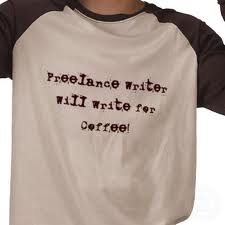 You know how they say you shouldn’t quit your day job to become a full-time writer? Well, last Thursday at David Wolinsky’s workshop at “Open Books Chicago” on freelancing I met three(!) people who did exactly the opposite – they quit their well-paid corporate jobs to pursue another career: writing. I left empowered and encouraged to start investing more in the dream of mine: dedicate all my time to writing for kids and freelancing as a travel journalist rather than working for someone 9-5.
You know how they say you shouldn’t quit your day job to become a full-time writer? Well, last Thursday at David Wolinsky’s workshop at “Open Books Chicago” on freelancing I met three(!) people who did exactly the opposite – they quit their well-paid corporate jobs to pursue another career: writing. I left empowered and encouraged to start investing more in the dream of mine: dedicate all my time to writing for kids and freelancing as a travel journalist rather than working for someone 9-5.
David started with describing things as they are in a freelance world: not promising at all. He said that nowadays people think that “freelancing” means writing for free. It’s not a joke, and some editors hope in the future that’s how it will be. Layoffs, buyouts and other scary things like content aggregators(special software that accumulates data from various websites for an article thus eliminating a necessity to hire a person to do a research and all “writing” in this case comes to “content architecture”-combining pieces of already written information) await everyone who dares to enter the industry.
So, what if you still want to write? It’s tough, but not impossible!
-Find gigs, not assignments. It’s the closest thing to security freelancers can get.
– Cultivate variety, meaning:where you’re working; are you doing it full-time? subjects you’re covering.
-Start publishing your stuff online. The more, the better.
– Internships are another great way to enter the industry.
– Set goals, deadlines, specific places to write for, certain amount of money you want to earn(pocket-money? legit second income?).
David stressed that to get started in a freelance world, it’s crucial to find people whose work you respect and reach out via email and let them know you enjoy their writing. It can look something like this(from David’s presentation):
SUBJECT: RE: Your (Smithsonian list) on (tall building)
Dear Gervasius,
My name is(your name) and I’m a writer and a (day job) in Chicago. I came across your(publication piece) and just wanted to let you know (your opinion). I especially enjoyed your (observation) that the (Superdome) resembled (a can opener). I hadn’t thought of it before, but now it’s all I can think of!
Keep up the good work!
Thanks!
(Reader Readerson).
Give them 7-10 days and if they don’t answer-move on.Most probably they will if you mention that you are a writer as well:) Networking is a key in the freelancing world. They might get you in touch with an editor whom you can pitch.
David also mentioned a great way to find out what magazines are currently interested in: they have a Media Kit link on their websites where they mention a list of things they plan to publish soon.
Thank you “Open Books Chicago” and David for conducting such a useful workshop!
By the way, my first volunteering field trip with “Open Books” will take place this upcoming Thursday, May 24th and I will keep you posted.
For all those who want to make an impact on a child’s life through literacy promotion and who live in Chicago, click this link and enroll in volunteering with “Open Books” now!




![20130801_122959[1]](https://olgaivanidiauthor.wordpress.com/wp-content/uploads/2013/10/20130801_1229591.jpg?w=300&h=225)

![20130730_100744[1]](https://olgaivanidiauthor.wordpress.com/wp-content/uploads/2013/10/20130730_1007441.jpg?w=300&h=225)
![20131006_231251-1[1]](https://olgaivanidiauthor.wordpress.com/wp-content/uploads/2013/10/20131006_231251-11.jpg?w=300&h=207)
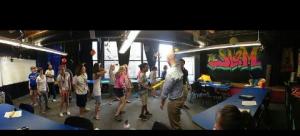


![20130731_102756[1]](https://olgaivanidiauthor.wordpress.com/wp-content/uploads/2013/10/20130731_1027561.jpg?w=300&h=225)



![20130919_192236[1]](https://olgaivanidiauthor.wordpress.com/wp-content/uploads/2013/10/20130919_1922361.jpg?w=225&h=300)
![20130919_192906[1]](https://olgaivanidiauthor.wordpress.com/wp-content/uploads/2013/10/20130919_1929061.jpg?w=225&h=300)
![20130919_191115[1]](https://olgaivanidiauthor.wordpress.com/wp-content/uploads/2013/10/20130919_1911151.jpg?w=300&h=225)
![20130919_210347[1]](https://olgaivanidiauthor.wordpress.com/wp-content/uploads/2013/10/20130919_2103471.jpg?w=268&h=300)

